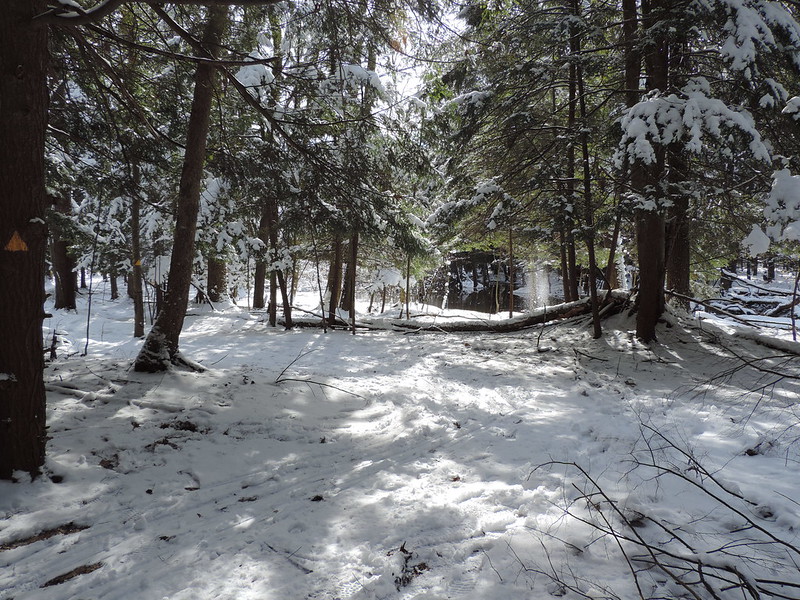Something beneath my feet is stirring. If I stand still, and tilt my face toward the sun, there is a sensation of movement, of an ancient force awakening that triggers reactions by the thousands. I can feel it within myself as well, this unnamed presence that stirs souls in mid-February.
I walked out of the house last weekend and the birdsong was startling. A Carolina Wren was ‘tea-kettling’ his heart out in the hillside brush pile. Tufted Titmice sang in droves their annual sugar song, ‘sweeter-sweeter-sweeter’ and heightened my anticipation for maple syrup season. Chickadees filled in the gaps with a ‘see-saw’ cheer and a handful of Blue Jays, Cardinals, and Mourning Doves leant their voices to the chorus. I faintly heard a murmuring Eastern Bluebird twice. It was 18 degrees Fahrenheit, and I would not have expected those sounds, but a force greater than weather alone drives the spring awakening.

Skunks hear it calling, too, and emerge from their winter dormancy to waddle through the snow seeking mates. As I thought about that I wondered if the origin of the Pepé le Pew cartoon was actually a frustrated naturalist who knew that skunk love and Valentine’s Day often went hand-in-hand. I personally love skunks and make sure that there are tidbits left under the bird feeder in the evenings to give them the energy they need.
The mammals who mated in the fall and use delayed implantation as a reproductive method begin to grow those paused cells. The dreams of babes fill the minds of otters, mink, and beavers. This allows the females to give birth at the best time, when food is plentiful and weather is favorable.

While snowshoeing the other day, I noticed many places along the field edge where, as the forest limbs reach out and over, perfect little circles imprinted in the snow, as if someone had punched a quarter-inch dowel in a random pattern. The trees are stirring too, sending their winter reserves from root to branch in preparation of bursting bud and feasting on sunlight. Broken branches from winter’s wind are bleeding, dripping the valuable sap into the snow. Soon, as I mentioned, we will tap the maple trees and take a bit of that energy to sustain ourselves. The spring awakening captured in amber sweetness.
In the wet swamps and marshes, the most remarkable of the plants is getting ready to literally burst forth. Skunk Cabbage generates enough heat — through the same respiration rate of a small mammal — to melt through inches of snow and cover the lowlands with their foul-smelling flowers. That fetid scent attracts flies, one of the few flying insects in February, who visit in hopes of obtaining a carrion snack but instead pollinate the plant in disappointment. They are rewarded with a warm room, however, and so the visit is not completely a waste.

Even the humans take note, though they may not realize it. February is both the end of winter and the beginning of spring. It is both the longest month, and the shortest. This is the time when the days actually feel longer, even though they’ve been getting longer for two months. This is when the primal part of ourselves senses the shift, hears the beckoning.
Take a winter walk, or a winter sit on a sunny day. Listen carefully to the world around you. Those that sing are boisterous. Those that grow, hum with life. And deep beneath your feet, the very heart of the land is shifting, preparing to leap forth to strive, thrive, love, reproduce, grow, and set seed. The winter sleep makes it possible. The dull lullaby of cold provides the world the rest it needs.
Yet now, feel it, sense it, smell it, that revitalizing tremor reverberating through all living cells. Tip your face to the sun and close your eyes. Match your breathing to that of the land, the trees, the sleeping seeds. Listen. And let your soul connect with all others and reap the reward that is rising.
Sarah Hatfield is Education Coordinator at ACNC.
Audubon Community Nature Center builds and nurtures connections between people and nature. ACNC is located just east of Route 62 between Warren and Jamestown. The trails are still open from dawn to dusk as is Liberty, the Bald Eagle. The Nature Center is partially open, including restrooms, the Blue Heron Gift Shop, and some exhibits. More information can be found online at auduboncnc.org or by calling (716) 569-2345.


Recent Comments